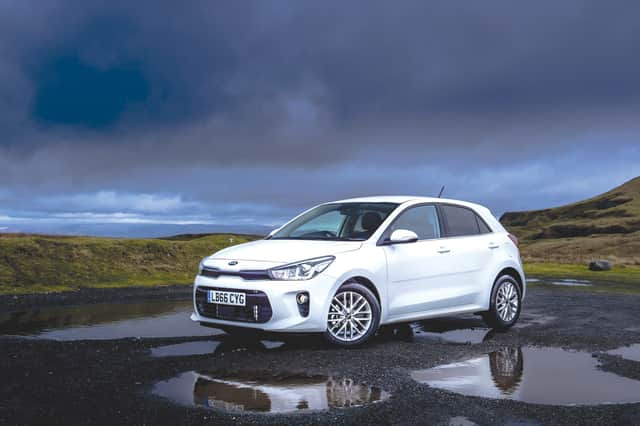MOTORS REVIEW: Kia Rio


Solid and functional, but where’s the flair?
I tuned in to Ramsey’s Kitchen Nightmares USA the other day.
Don’t ask me why, but after witnessing the disaster that was the lost in translation US version of Ricky Gervais’smash hit TV series The Office, I’ve had a morbid curiosity about just how poorly UK shows travel across the Atlantic.
Advertisement
Hide AdAdvertisement
Hide AdAside from the hilarity of seeing Jeremy Kyle nervously face-down some 20-stone deep south “trailer trash” rather than a drug-addled divorcee from Grimsby, I’ve yet to find any added humour or entertainment from a show that’s made the transition.
What I was surprised to find with Ramsey’s show was that — aside from the more emotional restaurant owners that the sweary pseudo-Scot is brought in to help — the formula is much the same.
He can hold his own in the face-offs, of course, and his advice remains the same… cut the menu in half and keep the food offering simple and straightforward.
We’ve heard these pearls of wisdom a million times before.
In the world of motoring it seems that manufacturers have turned away from what seems to be the catering industry’s common-sense approach to “give customers what they want” in the B-segment.
Advertisement
Hide AdAdvertisement
Hide AdThe average hatchback now comes with choices that range from premium audio systems to mood lighting andpaintwork to match your favourite pair of trousers.
Nissan’s Micra, Citroen’s C3 and the Mini all prioritise personalisation in their latest forms.
Kia is doing things differently.
No two-tone paint option, no mood lighting, and bodywork which is a subtle reworking of what came before.
Narrower, some might say more aggressive headlights, a more upright grille and a shape that is slightly more squareset, with crisper lines is a subtle reworking of the Rio launched back in 2011.
Advertisement
Hide AdAdvertisement
Hide AdIt is longer (+15mm) and lower (- 10mm) than the previous model, with a 10mm longer wheelbase, and interior space has improved, however.
There is now reasonable rear headroom for a six-foot passenger — something that cannot be said of the Citroen or Nissan — and boot capacity is up by almost 13 per cent to 325 litres.
The fuel tank is also two litres larger at 45 litres.
Customers can choose from the simply- named 1, 2 or 3 trims and a choice four engines available with manual or automatic gearboxes.
New for the fourth-generation Rio is a one-litre T-GDi turbocharged petrol engine available with either 99 or 118bhp.
Advertisement
Hide AdAdvertisement
Hide AdThe Rio tested here is the 1.4-litre CRDi turbodiesel version in “3” specification. With 89bhp and a useful 240lb.ft. of torque it is good for a claimed 11.6 dash to 62mph and 108mph top speed.
Make more gentle progress and Kia claims a somewhat optimistic 73.4mpg combined fuel economy claim with 98g/km CO2 emissions.
I managed 65mpg+ with relative ease.
A price tag of £17,245 is comparable to the top-of-the-range Micra and C3, while almost competing with Volkswagen’s sporty Polo R-Line, snazzy personalisation options or no.
Maybe you won’t see the need for any options.
The Rio does not have the kerb appeal to match these cars, but it does have an impressive standard specification.
Advertisement
Hide AdAdvertisement
Hide AdIf you are not the sort of person to have your head turned by snazzy paint hues, contrasting roof and door mirror colours and sporty trims, then the Rio 3’s standard spec ticks a lot of boxes.
All Rios, apart from the entry-level grade, have Autonomous Emergency Braking and a Lane Departure Warning system.
Another new feature is Cornering Brake Control, which applies brake pressure in tight curves to counter loss of traction, and Hill-start Assist which is standard across the range.
The interior of my test car was designed around the new 7.5-inch touchscreen infotainment display.
Advertisement
Hide AdAdvertisement
Hide AdIncorporating Apple CarPlay and Android Auto smartphone connectivity for the first time, the new system also has a reversing camera and Kia Connected Services, including TomTom traffic updates for the sat-nav.
Other highlights of the “3” specification include heated front seats and steering wheel.
But the design flair that has become a hallmark of many of the Kia’s rivals is sorely missing.
The Citroen C3’s tactile and original design features, the Micra’s colour and sheer quality, are both missing from the Kia, where horizontal lines and dark plastic surfaces abound.
Advertisement
Hide AdAdvertisement
Hide AdThe Rio feels solid, purposeful and functional, but fails to get the heart aflutter.
There’s a similar sense of workmanlike reliability about the way it handles.
Kia’s uncommunicative steering still seems to be a bit of an issue, with a numb feeling around the straight ahead and a reluctance to self-centre, while the chassis is predictable rather than fun or lively.
For day-to-day duties, the Rio has so much of the job licked, with reasonable comfort and more interior space than its key rivals, but it just fails to generate any of the emotion that some owners in the B-segment seem to now crave.
Advertisement
Hide AdAdvertisement
Hide AdOverall, there is a sense that Kia has created a hatchback that is worthy rather than sparkling.
With the colourful C3 and impressive Micra among the key rivals now boasting appeal in other areas, I think even Gordon might call for a little more flair and imagination be added to the menu...